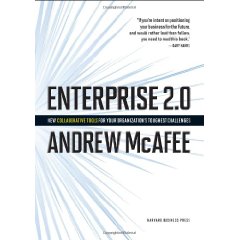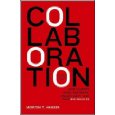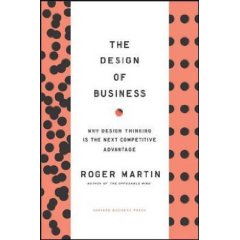Yes, right – one of my small observations at the E20SUMMIT deals with “printed paper” – and it’s importance for the advancement of Enterprise 2.0.
Gil Yehuda said at the SUMMIT that we need to choose the right words and a common vocabulary when communicating (with the C-level I think especially). It’s probably a matter of media channel too …
 One of the books that was discussed quite a lot was Andrew McAfee’s book “Enterprise 2.0: New Collaborative Tools for your Organization’s Toughest Challenges” (Disclosure: I am going to write a detailed review soon, after all I was given the book by Andrew’s agent at HBS Publishing knowing that I’m a blogger and would probably write about it – no further arrangements have been made and I am writing my honest opinions anyway). Apparently he signed and sold hundreds of them at last weeks Enterprise 2.0 conference, the stacks look impressive for sure (see the photo by Dion Hinchcliffe who managed to be among the first in line …)
One of the books that was discussed quite a lot was Andrew McAfee’s book “Enterprise 2.0: New Collaborative Tools for your Organization’s Toughest Challenges” (Disclosure: I am going to write a detailed review soon, after all I was given the book by Andrew’s agent at HBS Publishing knowing that I’m a blogger and would probably write about it – no further arrangements have been made and I am writing my honest opinions anyway). Apparently he signed and sold hundreds of them at last weeks Enterprise 2.0 conference, the stacks look impressive for sure (see the photo by Dion Hinchcliffe who managed to be among the first in line …)
 Next up with various recommendations from various people was Morton Hansen’s book “Collaboration: How Leaders Avoid the Traps, Build Common Ground, and Reap Big Results” – funny how everybody thinks this might be interesting for me 😉
Next up with various recommendations from various people was Morton Hansen’s book “Collaboration: How Leaders Avoid the Traps, Build Common Ground, and Reap Big Results” – funny how everybody thinks this might be interesting for me 😉
I should probably check it out as well, but I may have to wait until my trip to the U.S. for Lotussphere to lay my hands upon one.
…
 Frank Schoenefeld’s book “Praxisleitfaden Enterprise 2.0. Wettbewerbsfähig durch neue Formen der Zusammenarbeit, Kundenbindung und Innovation. Basiswissen zum erfolgreichen Einsatz von Web 2.0-Technologien” is one german language entry into this field, at the SUMMIT he said that there may be an english translation coming up … (Disclosure again: I was given the book by Frank Schoenefeld, all other rules and remarks stay the same as above …)
Frank Schoenefeld’s book “Praxisleitfaden Enterprise 2.0. Wettbewerbsfähig durch neue Formen der Zusammenarbeit, Kundenbindung und Innovation. Basiswissen zum erfolgreichen Einsatz von Web 2.0-Technologien” is one german language entry into this field, at the SUMMIT he said that there may be an english translation coming up … (Disclosure again: I was given the book by Frank Schoenefeld, all other rules and remarks stay the same as above …)
Last one in the list of “newly published” paperworks is the 20Adoption Council‘s first report on how to “roll out e20 in a large enterprise”. Sounds interesting too, and I should ask Susan or Gil about it sometime soon …
The 2.0 Adoption Council is conducting ground-breaking research on its members. As each member is screened for eligible membership in the Council, our data set is among the best in the business for early adoption of 2.0 technologies and practices.
[…] Who should buy this report?
- CEOs, CIOs, and CFOs now engaged in or planning an 2.0 strategy and execution
- Companies competing or partnering with 2.0 platform and solution vendors
- IT managers charged with providing 2.0 capabilities to their enterprise workforce
- Vendors developing community management strategies for their customers
- KM, HR, R&D managers interested in how to leverage 2.0 for the enterprise
- Venture capitalists, analysts, investment bankers, and advisors in the 2.0 consulting arena [this sounds pretty much like me, huh?].
PS. another meme I thought a bit present at the SUMMIT was “social business design”. One personal reason for this was the presentation by Jeff Dachis at the E2Conf in San Francisco I listened into the week before, another one Lee Bryant’s presentation on new forms of leadership in decentralized organizations (where he employed Dachis Group visualizations of social business design archetypes) and last reason’s Dion’s observation in both masterclass and closing note that it’s about competitive advantages (and those are the focus and goal of business model innovation and design) primarily when we deal with Enterprise 2.0.
That said I thought it cool to link to some more books on my reading list, as much from the design thinking as from the business model innovation sphere. Beginning with Design Thinking: Integrating Innovation, Customer Experience, and Brand Value by Thomas Lockwood which was recommended to me at the SUMMIT, then it’s A Fine Line: How Design Strategies Are Shaping the Future of Business by Hartmut Esslinger and Change by Design: How Design Thinking Transforms Organizations and inspires Innovation by Tim Brown of Ideo up on the slate.
 And last but not least it’s The Design of Business: Why Design Thinking is the next competitive advantage by Roger Martin where it’s time to add another disclaimer: I am going to write a detailed review soon, after all I was given the book by Roger’s agent at HBS Publishing knowing that I’m a blogger and would probably write about it – no further arrangements have been made and I am writing my honest opinions anyway (be it at my other blog Business Model Innovation and Design or here).
And last but not least it’s The Design of Business: Why Design Thinking is the next competitive advantage by Roger Martin where it’s time to add another disclaimer: I am going to write a detailed review soon, after all I was given the book by Roger’s agent at HBS Publishing knowing that I’m a blogger and would probably write about it – no further arrangements have been made and I am writing my honest opinions anyway (be it at my other blog Business Model Innovation and Design or here).
Well, after I’ve finished my little series on E20SUMMIT learnings, part 4 coming soon.

